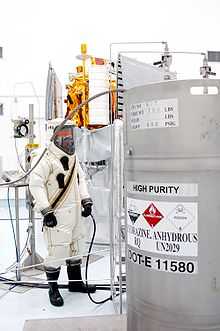Hypergolicity

Hypergolicity is a property of some rocket fuels , the components of which react spontaneously when they are brought into contact or mixed with one another. The term hypergole comes from the German Wolfgang Carl Nöggerath (1908–1973), who used this name for self-igniting fuel mixtures such as. B. the Messerschmitt Me 163 used for the first time.
Properties and use
ignition
The components of hypergolic fuels are mostly strong oxidizing and reducing agents that ignite immediately, sometimes explosively, on contact. Because the fuel reacts and burns immediately after it has been injected into the combustion chamber, too much fuel can never accumulate in the combustion chamber before the engine is ignited. Ignition occurs in any case, which is essential for weapon systems such as ICBMs and upper stages of launch vehicles. Hypergolic fuels are also used for ignition in some engines. Engines that burn hypergolic fuels do not require complex ignition devices and can ignite multiple times. This is why hypergolic fuels are often used in correction engines, as these often have to be ignited and the number of ignitions is not always known beforehand.
Pollution and storage
The components of hypergolic fuels are often highly reactive and therefore mostly toxic, unstable and difficult to store. For larger weapon systems, solid fuel boosters have therefore been used . Since hypergolic fuels pose a threat to humans and the environment, they are rarely used in the first stages. Hydrazine - derivatives with dinitrogen tetroxide are now the single hypergolic fuels that are still used. They are poisonous, but since they can be stored for a long time without cooling (unlike liquid hydrogen , for example ), they are used by satellites and space probes or in upper stages of rockets. Manned spaceships (e.g. the space shuttle ) also mostly use them for their correction engines. In addition, military missiles can be kept ready for launch for a long time without great technical effort.
Specific impulse
Hypergolic fuels usually do not have a very high specific impulse , which is why they are rarely used when thrust is to be provided efficiently, for example in large rocket stages. However, since they do not require tank insulation, cooling systems or ignition devices, which add weight, it is worth using them for correction engines, for example.
Examples
Examples of hypergolic fuels are:
- Dimethylhydrazine and dinitrogen tetroxide (the most widely used hypergol, e.g. used in the proton )
- Methyl hydrazine and dinitrogen tetroxide (e.g. used in the EPS upper stage of Ariane 5 )
- Dimethylhydrazine and nitric acid
- Hydrazine and nitric acid
- Aniline and nitric acid
- Hydrogen peroxide and a mixture of hydrazine hydrate , methanol and 13% water
- Highly concentrated hydrogen peroxide and RP-1
literature
- Armin Dadieu, Ralf Damm, Eckart W. Schmidt: Rocket fuels . Springer-Verlag, 2013, ISBN 978-3-7091-7132-5 .
- Thomas M. Klapötke: Chemistry of high-energy materials . Walter de Gruyter, 2009, ISBN 978-3-11-021487-1 .